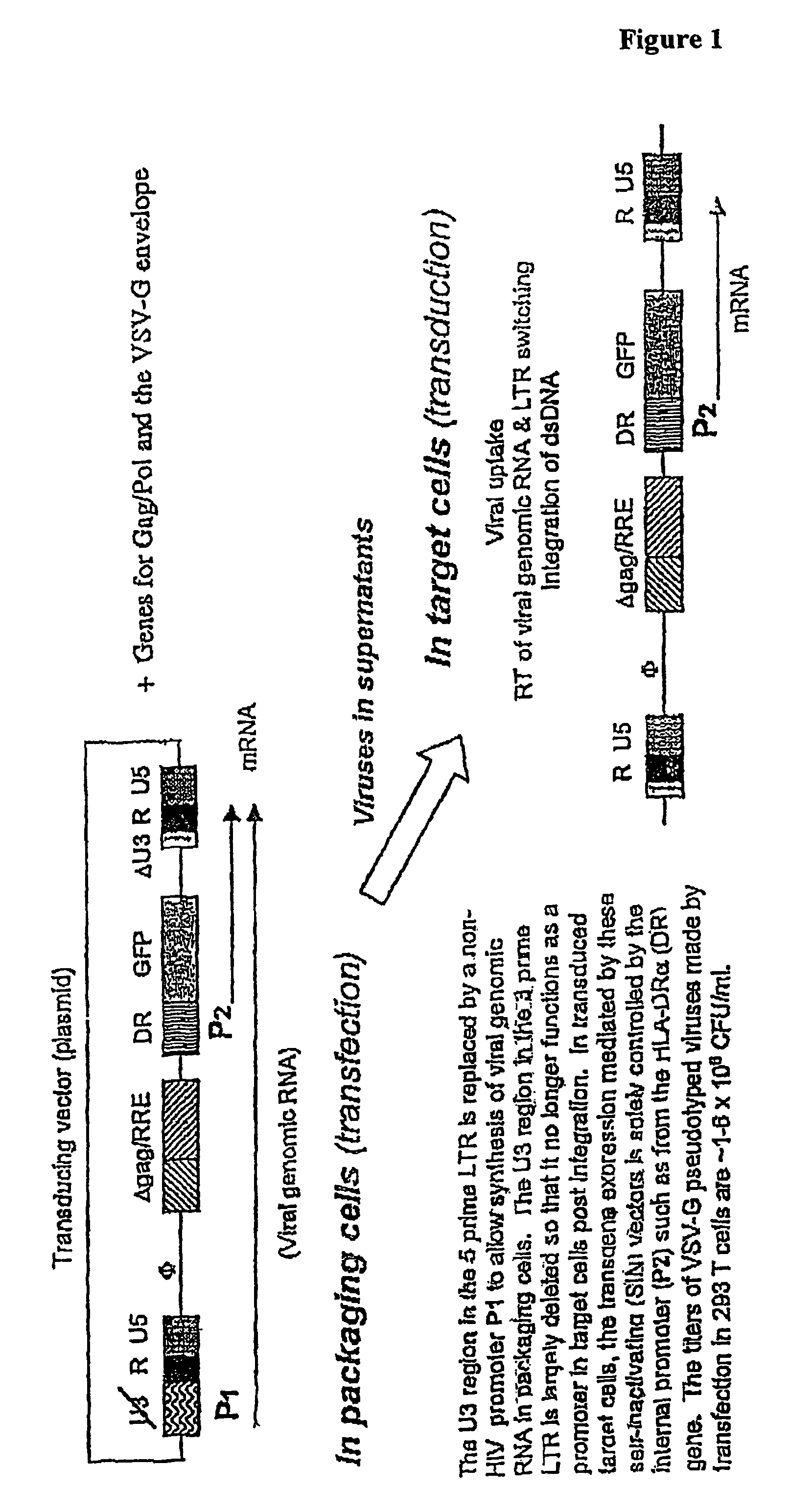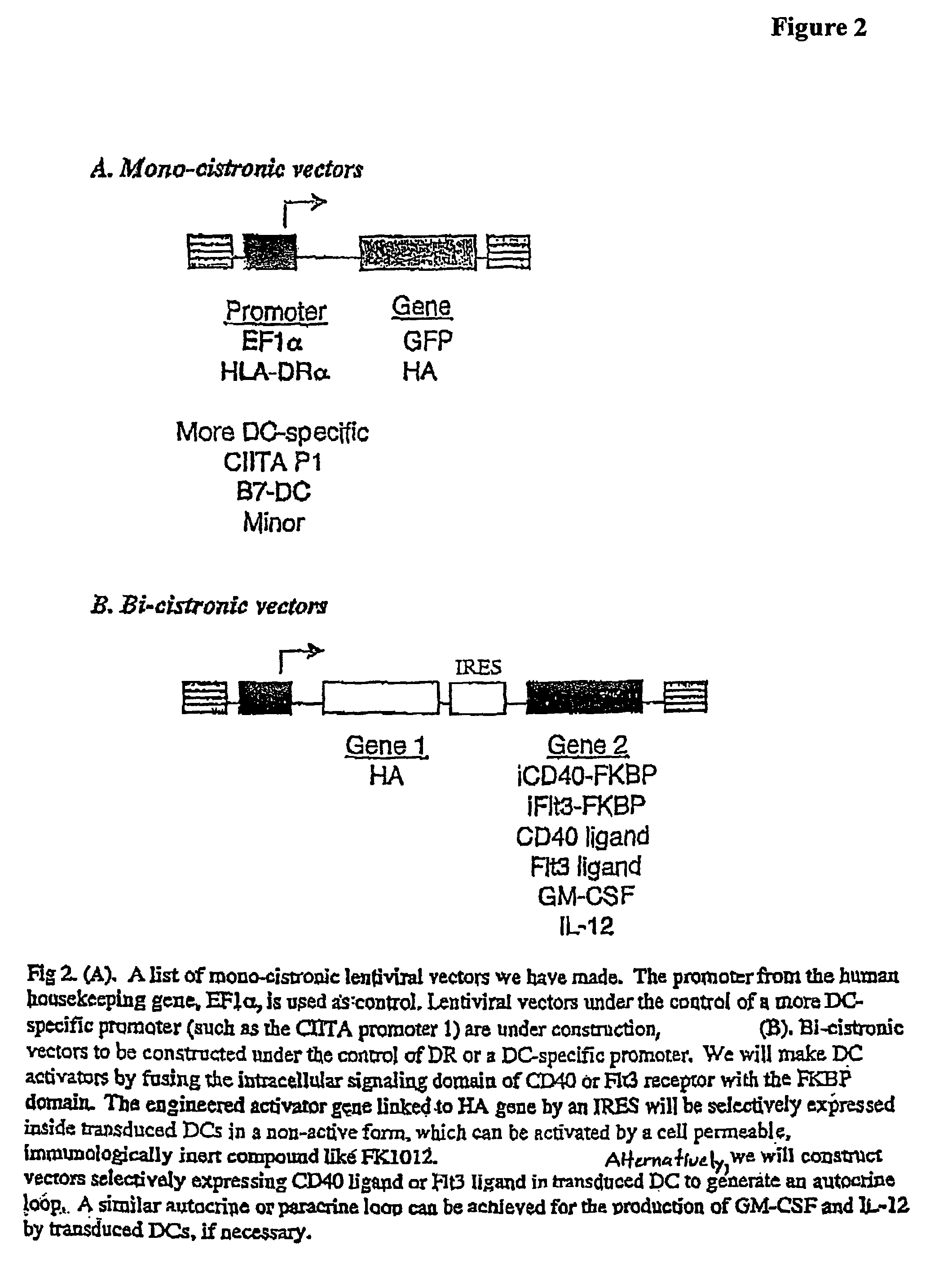Modulation of systemic immune responses by transplantation of hematopoietic stem cells transduced with genes encoding antigens and antigen presenting cell regulatory molecules
a technology gene encoding, which is applied in the field of systemic immune response modulation by transplantation of hematopoietic stem cells transduced with genes encoding antigens and antigen presenting cell regulatory molecules, can solve the problems of low efficiency of standard immunotherapy and vaccine approaches in introducing antigens into apcs, potential deleterious ability to insert genes into host cells' genomes, and inappropriate expression of antigens
- Summary
- Abstract
- Description
- Claims
- Application Information
AI Technical Summary
Benefits of technology
Problems solved by technology
Method used
Image
Examples
example 1
Approach to Efficient Recombinant Antigen Expression
[0274]Effective induction of systemic anti-tumor immunity requires optimal tumor antigen presentation by major histocompatibility complex (MHC) molecules simultaneously with appropriate costimulatory signals. Pardoll, D. M. (1998), Nat. Med 4:525; Herlyn, D. and Birebent, B. (1999), Ann. Med. 31:66; Banchereau, J. and Steirnan, R. M. (1998), Nature 392:245; and Hart, D. N. J. (1997), Blood 90:3245. Many therapeutic and preventive tumor vaccination approaches have focused on engineering APCs, particularly DCs. While DC-based vaccines are now popular, recent studies using ex vivo antigen-loaded DC as cancer vaccines have shown limited success. This appears to be due, in part, to inefficient numbers of ex vivo differentiated DCs that home to relevant lymphoid compartments, thereby limiting their access to T cells. DNA vaccines are relatively inefficient in transducing DCs in vivo, as demonstrated by the paucity of transduced DCs found...
example 2
HSC Gene transduction by LV and Oncoretroviral Vectors (RV)
[0276]With improved methods for HSC culture and virus production, we can now transduce human HSC, assayed as SCID-repopulating cells (SRC) in NOD / SCID mice, using RV or LV. These methods are described in: Cheng, L. et al. (1997), Gene Therapy 4:1013; Cheng, L. et al. (1998), Blood 92:83; Novelli, E. et al. (1999), Human Gene Therapy 10:2927; Gao, Z. et al. (2000), Molecular Therapy 1:35S; Gao, Z. et al. (2001), Stem Cells, in press; and Cui, Y. et al. (2000), Exp. Hematology 27:62a, the contents of which are incorporated by reference. Recently we have made a direct comparison of MSCV-based RV with HIV-based LV for SRC gene transduction. These (see Gao, Z. et al. (2000), Molecular Therapy 1:35S; and Gao, Z. et al. (2001), Stem Cells, in press) and other data demonstrate that LV require less ex vivo manipulations and are more efficient to transduce human HSC than RV.
example 3
Stable and Targeted Transgene Expression Mediated by LV
[0277]It has generally been difficult to construct high-titer RV whose transgenes are solely under the control of a non-viral (internal) promoter. Recently it was demonstrated that specific transgene expression controlled by an internally-built specific promoter is more readily achieved using LV with self-inactivating modification; Cui, Y. et al. (1999), J Virology 73:6171; and Zufferey, R. et al. (1998), J. Virol. 72:9873; which disables the basal promoter function of the LV LTR post integration (FIG. 1). Since this project depends in part on generating DC-specific gene expression, the superiority of LV to RV in this regard further validates LV as the vector of choice. We began by using a SIN vector (EF.GFP) in which transgene expression (GFP) is controlled by the promoter of a human housekeeping gene, EF1a (FIG. 2A). To further examine the feasibility of selective transgene expression in APCs, we made the DR.GFP vector. In thi...
PUM
| Property | Measurement | Unit |
|---|---|---|
| temperature | aaaaa | aaaaa |
| temperature | aaaaa | aaaaa |
| temperature | aaaaa | aaaaa |
Abstract
Description
Claims
Application Information
 Login to View More
Login to View More - R&D
- Intellectual Property
- Life Sciences
- Materials
- Tech Scout
- Unparalleled Data Quality
- Higher Quality Content
- 60% Fewer Hallucinations
Browse by: Latest US Patents, China's latest patents, Technical Efficacy Thesaurus, Application Domain, Technology Topic, Popular Technical Reports.
© 2025 PatSnap. All rights reserved.Legal|Privacy policy|Modern Slavery Act Transparency Statement|Sitemap|About US| Contact US: help@patsnap.com



